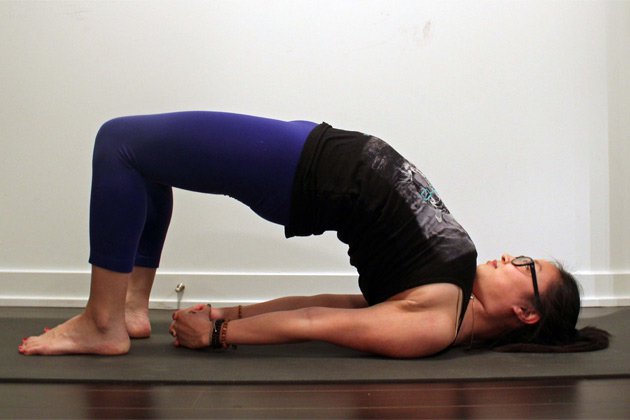I like to think of Bridge pose (Setu Bandhasana) as a way to bridge the gap between body and mind. Physically, the feet and head are grounded to the earth, but the heart is lifting exuberantly towards the heavens. As a milder backbend with many different options, this pose is a wonderful introduction to the benefits of backbending/heart-opening poses, which include increased relaxation, mental calm, and a sense of rejuvenation.
Benefits Of Bridge Pose:
Bridge pose offers a nice stretch for the upper and front body — chest, shoulders, neck, spine, front legs — and is a strengthening pose for the back body — back, buttocks, and hamstrings. Bridge pose also stimulates and massages the abdominal organs, which helps to improve digestion. Since this pose acts as a mild inversion, with the heart higher than the head, it can calm your brain and central nervous system, promoting ease and relaxation in the body and mind. Practice this pose with caution if you have any neck, knee or back injuries.
Bridge Pose Step-By-Step:
- Begin lying comfortably on your back in a supine position. Allow the back of your head and the backs of your shoulders to rest on the ground, and avoid moving your head from side to side as you enter this pose to protect your neck.
- Bend your knees and place the soles of your feet flat down on your mat. Ensure that the feet are parallel and separated about hip distance apart, and that your weight is distributed evenly across the soles of both feet.
- Walk your feet in towards you until you can just graze your heels with your fingertips. Root your feet down strongly into the ground.
- On an inhale, lift your hips up high toward the ceiling and begin to walk your shoulders underneath you. Interlace your fingers and press your forearms down into the mat to get more lift in the hips.
- Note the tendency for the knees to want to splay apart as the hips lift higher and firm up through the inner thighs without gripping the buttocks. Squeezing a block between the knees can be helpful to keep the thighs hip distance apart and parallel here.
- Continue to refine the pose by moving your chest towards your chin (not chin to chest!), lengthening your tailbone towards your feet, and perhaps most importantly, relaxing your face.
- Hold the pose for 5 full, deep breaths.
- On an exhale, release the clasp of your hands, begin to walk your shoulders out from underneath you, and slowly roll down onto the ground, one vertebra at a time. Feel free to bend your knees into your chest and wrap your arms around your legs for a well-deserved hug.
Tips:
- A restorative version of Bridge pose with a block or bolster underneath the sacrum is a divine way to release the low back and can also help to ease menstrual cramps and discomfort.
- Bridge pose is a great alternative for full Wheel pose (Urdvha Dhanurasana) on days when you’re feeling lower in energy or if you are just starting out with working toward practicing full Wheel.
- If it feels like too much to have the fingers interlaced beneath you, you may simply keep your arms alongside you with your palms facing down toward the ground as opposed to clasping the hands.
- For an added challenge, try bending one knee into your chest, then extending the lifted leg straight up towards the ceiling. You can also do so after coming up onto the balls of the feet to lift the hips higher and bending your elbows (forearms perpendicular to the ground) to place the palms of your hands underneath your low back (with your fingertips pointing out to the sides).


